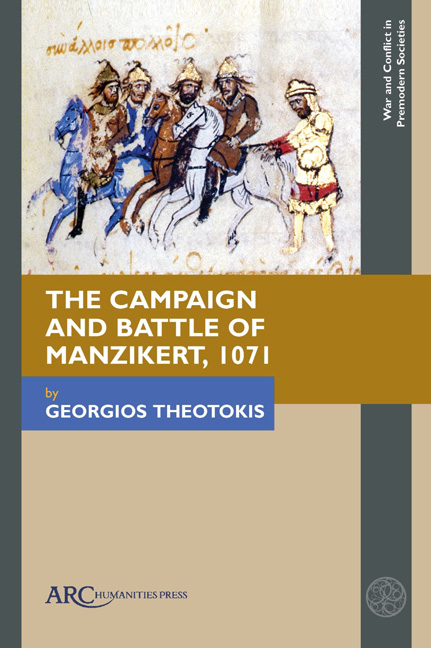Book contents
- Frontmatter
- Dedication
- Contents
- List of Illustrations
- Introduction
- Chapter 1 Christian and Muslim Sources for the Battle of Manzikert: Making Sense of the Professional and Cultural Milieu
- Chapter 2 Christian and Muslim Sources for the Battle of Manzikert: Making Sense of the “Battle-Piece"
- Chapter 3 Christian and Muslim Sources for the Battle of Manzikert: Making Sense of Numbers and Local Topography
- Chapter 4 The Geopolitical and Military Background to the Battle of Manzikert
- Chapter 5 The Prelude to the Battle of Manzikert
- Chapter 6 The Battle of Manzikert
- Chapter 7 The Aftermath of the Battle of Manzikert
- Conclusions
- Select Bibliography
- Index
Chapter 5 - The Prelude to the Battle of Manzikert
Published online by Cambridge University Press: 08 May 2024
- Frontmatter
- Dedication
- Contents
- List of Illustrations
- Introduction
- Chapter 1 Christian and Muslim Sources for the Battle of Manzikert: Making Sense of the Professional and Cultural Milieu
- Chapter 2 Christian and Muslim Sources for the Battle of Manzikert: Making Sense of the “Battle-Piece"
- Chapter 3 Christian and Muslim Sources for the Battle of Manzikert: Making Sense of Numbers and Local Topography
- Chapter 4 The Geopolitical and Military Background to the Battle of Manzikert
- Chapter 5 The Prelude to the Battle of Manzikert
- Chapter 6 The Battle of Manzikert
- Chapter 7 The Aftermath of the Battle of Manzikert
- Conclusions
- Select Bibliography
- Index
Summary
Diogenes's Campaigns of 1068 and 1069
Emperor Romanos's choice of Hierapolis and northern Syria as the main area of opera-tions for the 1068 campaigning season, rather than, for example, the northeastern (“anti Taurus”) region in Asia Minor, should be attributed to the military pressure brought upon the ducate of Antioch by the Seljuk raiding parties led by Afşin Bey, Sunduq al Turki, Ahmetşah, Türkman, Demleçoğlu Mehmet, Duduoğlu, Serhenkoğlu, and others. These particular groups, but especially the one led by Afşin, were launching increasingly destructive raids both in the frontier regions and in the interior of Asia Minor, as we saw in the previous chapter. Afşin's intention may well have been to disrupt the communica-tions between Edessa and Antioch, considering his victory over the doux of Edessa in 1066, and his wintering at the foot of the Black Mountains, only 90 kilometres north of Antioch, the following year.
Attaleiates makes a reference to Alp Arslan “detaching a fairly large contingent that he divided into two parts and encamped in upper Asia, placing the one more to the north and the other to the south,” which should be understood as the sultan's strategic response to the news of Diogenes's campaign preparations in the theme of Anatolikon, assigning large detachments in both the northern (Caucasus and Armenia), and the southern (Edessa and Syria) operational areas. A few lines later Attaleiates also notices that “the Persian army to the north…gave the impression that it was withdrawing before the emperor's advance,” hinting at the apparent departure of the main Seljuk army from the Caucasus region. Accordingly, we see Romanos's reaction in his advance southeast to the small theme of Lykandos, to the west of Melitene, instead of marching north to Sebasteia and Koloneia, evidently in preparation for an invasion of Syria.
The strategic and tactical inability of the cumbersome imperial forces to block or intercept the smaller and more mobile Turkish raiding parties became apparent when the emperor had to march back north to Sebasteia to deal with the aftermath of an “utterly unexpected” Turkish raid and pillage of Neokaisarea on the Lykos River, around 160 km to the northwest of Koloneia.
- Type
- Chapter
- Information
- The Campaign and Battle of Manzikert, 1071 , pp. 111 - 132Publisher: Amsterdam University PressPrint publication year: 2024

